-
@keyser You are more determined than I. I gave Zabbix a serious go a while back. It worked well in circumstances where an agent was available. However for SNMP devices, of which I have a large number, it required far too much work for me. I gave up after a couple of weeks.

-
@dennypage said in NUT package:
@keyser You are more determined than I. I gave Zabbix a serious go a while back. It worked well in circumstances where an agent was available. However for SNMP devices, of which I have a large number, it required far too much work for me. I gave up after a couple of weeks.

 Well it did take a little learning, But it’s actually rather simple and flexible. One just needs to understand the architecture.
Well it did take a little learning, But it’s actually rather simple and flexible. One just needs to understand the architecture. -
Hi all, I've noticed a published NUT 2.8.0 package with a lot of improvements.
Development has been more active this year with actually 2.8.1 started.
Is an updated BSD version of this package on the way ?Thanks to let know if someone knows about it.
-
@filecity said in NUT package:
Hi all, I've noticed a published NUT 2.8.0 package with a lot of improvements.
Development has been more active this year with actually 2.8.1 started.
Is an updated BSD version of this package on the way ?It will probably be a few months. 2.8.0 represents 5+ years of changes, all rolled up into a single release. I expect that will take some time to stabilize.
-
 D dennypage referenced this topic on
D dennypage referenced this topic on
-
So I replaced my tower UPS with a rackmounted APC Smart-UPS that has a Network Management Card. What is the best way to have a central "UPS server"? Should I point NUT (in pfsense) to the APC UPS using the remote snmp driver and make NUT the main server for everything? Or would it be beneficial to make NUT and other clients as slaves and make the APC UPS as a server itself?
-
@kevindd992002 said in NUT package:
So I replaced my tower UPS with a rackmounted APC Smart-UPS that has a Network Management Card. What is the best way to have a central "UPS server"? Should I point NUT (in pfsense) to the APC UPS using the remote snmp driver and make NUT the main server for everything? Or would it be beneficial to make NUT and other clients as slaves and make the APC UPS as a server itself?
I have a Smart-UPS with an NMC2, and individual hosts speaking directly to the UPS via SNMP. I recommend this approach.
Be sure to assign a fixed address for the UPS. If you running the DHCP server on pfSense, I would also recommend enabling the static ARP option for the UPS (for good measure).
-
Hi. So I have this new UPS that has been added to NUT 3 months ago. I've tried nut-2.8.0 on RPi and it works fine. But I really like to have it handled by pfSense. Any changes on package upgrade to 2.8.0 in the near future?
-
@tnowak What is the UPS and how does it physically connect? Have you confirmed that it does not actually work with 2.7?
-
@dennypage That’s Ever Eco Pro CDS AVR 1200. It’s kind of new kid on the block. It uses usbhid-ups driver. I have tried 2.7 on both pfSense and RPi and it does not work. That UPS has been committed to nut driver 2-3 months ago according to GitHub source. It works fine in 2.8.
-
@tnowak I'll take a look
-
 D dennypage referenced this topic on
D dennypage referenced this topic on
-
@dennypage can you please help? My UPS has Automatic Voltage Regulation. With the summer heat on the power grid I noticed the input voltage goes from 115-118 volts ac so it has been kicking in a lot more. I think I must have adjusted the original setting to auto correct for anything under 119 volts ac during set up on a older version of this package. However the package now I can not find where that setting to adjustment when AVR should run anymore. The battery this week is getting hammered with the local grid. Last month we had a brownout I had never seen one until this year in California. Our fans everything was slow motion. My HiFi system said low voltage on the screen even a couple weeks ago. I am running in older CP1200AVR made by Cyber Power. I can not remember if you could change the UPS settings from inside of my Netgate firewall or not. It restored 100 of the batter charge after the brownout. However is there anyway to adjust AVR settings from inside of NUT? Or am I imagining this?
-
@jonathanlee You can adjust UPS settings via NUT, but you don't do it from within the GUI. To change UPS settings, use the upsrw command. Documentation is here. If you run upsrw without any options other than the UPS name, it will give you a list of variables that can be set.
-
@dennypage thank you this is exactly what I was looking for, the AVR settings I have set killed the battery with all the issues. It needs to be set to the normal 90 range again.
-
@dennypage We got some fresh batteries from Batteries plus today :) It keeps saying access denied. Is there a way to add users on the pfsense? I tried it won't take the add user command also. upsd.users won't work. The clock also will not run. This is for a Cyberpower CP1200AVR running driver USB usbhid. I thought originally a version back I could change the settings in the GUI and that it also had a port number. This new version for 22.05 seems to be missing the other settings like the password and options.
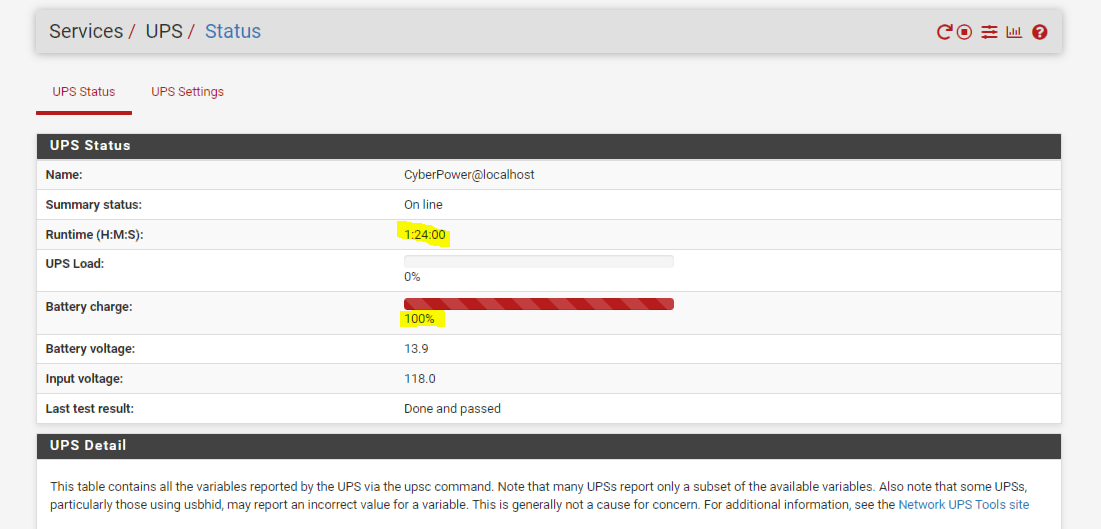
(GUI View)This thing saved me in a final once already. The power was out during a computer science final and this thing saved the day for the 5 mins it was out.
-
@jonathanlee said in NUT package:
We got some fresh batteries from Batteries plus today :) It keeps saying access denied. Is there a way to add users on the pfsense? I tried it won't take the add user command also. upsd.users won't work. The clock also will not run. ... I thought originally a version back I could change the settings in the GUI and that it also had a port number. This new version for 22.05 seems to be missing the other settings like the password and options.
I don't understand many things here. Can you clarify what "access denied" refers to? What does "clock also will not run" mean? What port number do you refer to?
Currently, no new version of the NUT package has been pushed for 22.05. There is a PR pending to update to 2.8.X, but the current version is still 2.7.4_10. Same as 22.01.
-
 G Gertjan referenced this topic on
G Gertjan referenced this topic on
-
 G Gertjan referenced this topic on
G Gertjan referenced this topic on
-
@dennypage thanks for all you do and the reply.
When I use the upsrw command with arguments to change items variables with = it displays access denied with my username and password I originally configured.I did configure a username and password for this package before however all those options are no longer listed inside of Pfsense.
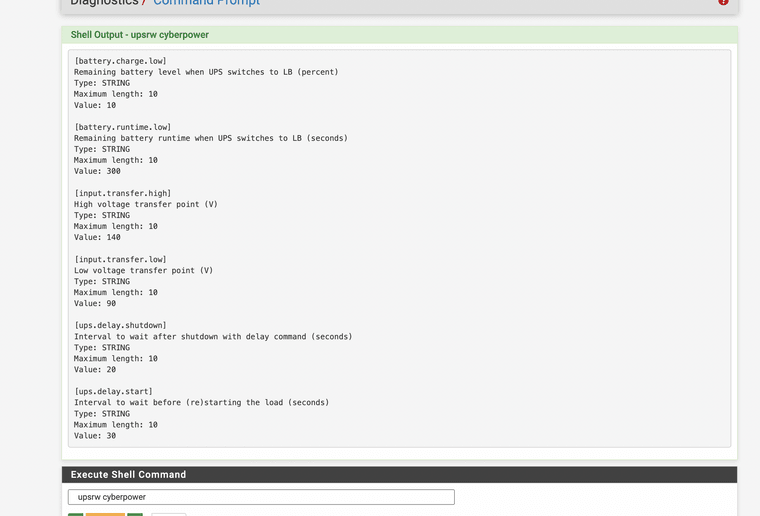
(Image: upsrw command I am talking about "ran without any arguments")
The clock I am referring to is the "runtime clock" for the UPS it stops and no longer continues inside the firewall.
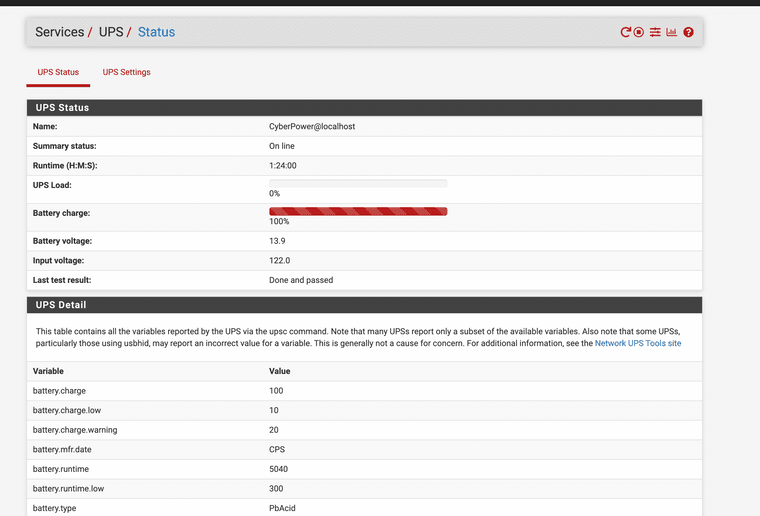
(Image: Runtime is not functional stays the same at 1:24:00 never changes)
The port number I am talking about would be how you access the firewall inside of a web browser url for example when I originally installed NUT it had me configure a username and password for the UPS and had a port for the Network use outside of the firewall. I think it's 3493 or something. So for example if I access the firewall with https://192.168.1.1:3493 I should be able to see the GUI for NUT.
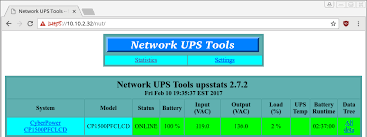
(Image: NUT being accessing with URL outside of firewall as seen with other users on the web I would like to be able to do this)
I am trying to access the URL for just the UPS similar to squids URL specific port.
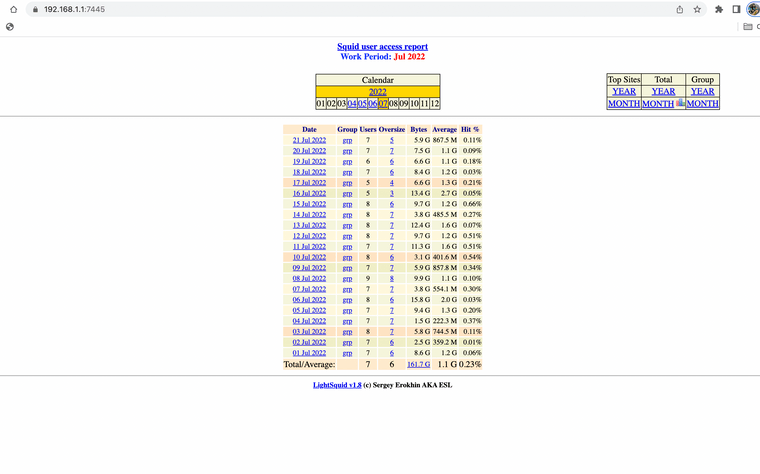
(Image: Squid's URL specific access uses port 7445)

(Image: USP load also stopped working it does work in 22.05 right after this package is freshly installed after it just displays zeros for me and does not change again)
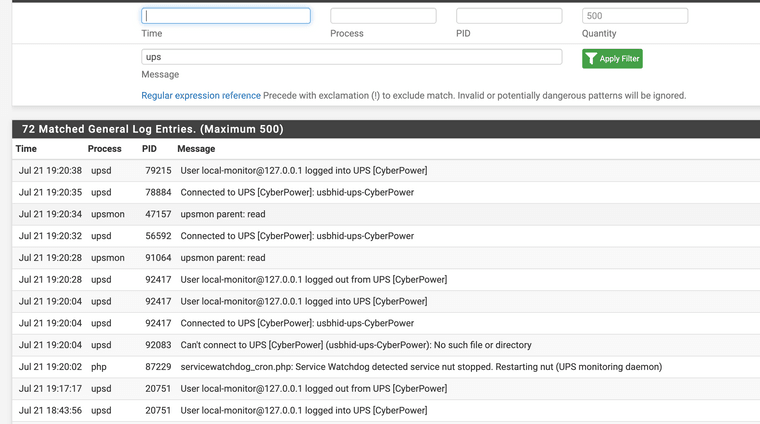
(Image: recent logs for UPS)
-
@jonathanlee said in NUT package:
@dennypage thanks for all you do and the reply.
When I use the upsrw command with arguments to change items variables with = it displays access denied with my username and password I originally configured.I did configure a username and password for this package before however all those options are no longer listed inside of Pfsense.
There is no specific input field for a username/password. Never has been. You may be thinking of the "Additional configuration lines for upsd.users" section in the Advanced settings. You could have added a user in there for supporting remote monitoring. But that user would not be able to perform administration tasks such as writing variables in the UPS.
The admin password for NUT is not configurable. It is randomly generated for security. You can find it by looking in /usr/local/etc/nut/upsd.users.
The clock I am referring to is the "runtime clock" for the UPS it stops and no longer continues inside the firewall.
...
(Image: Runtime is not functional stays the same at 1:24:00 never changes)Runtime is not the amount of time the UPS has been running. Runtime is the amount of time the UPS can power the load if mains are off. In other words, if power fails, your UPS is currently capable of sustaining the system for 1 hour and 24 minutes.
The port number I am talking about would be how you access the firewall inside of a web browser url for example when I originally installed NUT it had me configure a username and password for the UPS and had a port for the Network use outside of the firewall. I think it's 3493 or something. So for example if I access the firewall with https://192.168.1.1:3493 I should be able to see the GUI for NUT.
The NUT cgi GUI has never been part of the pfSense package. You must be thinking of a different system or package.
The two available NUT GUIs are the main status/detail page (Services->UPS->UPS Status), and the UPS Status widget available for install on the dashboard page (Status->Dashboard). Both of these are part of the main pfSense UI when the package is installed. There is no separate port.
-
So, I confess that, after I'd initially setup NUT, I'd been content with that fact that I could see UPS status and that it would probably function as intended in a power outage situation. We rarely lose power here and, when we do, it usually comes back in a few minutes, so I'd never hit an extended outage period before. However, I did hit that situation a few weeks ago and realized my pfsense (Netgate 3100) did not shutdown correctly.
I'd only just these past few days been able to truly play around with it to see what might be going on. I tried running upsmon -c fsd to simulate an outage and found the system shutdown the UPS in about 10 seconds, well before pfsense could actually shutdown. Here is what I see from the console when I run that command:
[22.05-RELEASE][root@pfSense.localdomain]/root: upsmon -c fsd Network UPS Tools upsmon 2.7.4 [22.05-RELEASE][root@pfSense.localdomain]/root: Netgate pfSense Plus is now shutting down ... Network UPS Tools upsmon 2.7.4 kill: No such process UPS: ups (master) (power value 1) Using power down flag file /etc/killpower Power down flag is set Network UPS Tools - UPS driver controller 2.7.4 Network UPS Tools - Generic HID driver 0.41 (2.7.4) USB communication driver 0.33 Using subdriver: CyberPower HID 0.4 Initiating UPS shutdown pflog0: promiscuous mode disabled ugen1.2: <CPS CP685AVRa> at usbus1 (disconnected)When it says "Netgate pfSense Plus is now shutting down", the UPS power turns off within 10 seconds and I see nothing in the logs about pfsense actually shutting down. It just goes from normal system messages to rebooting and I see it having to repair the file system (the repair messages don't seem to actually be in the system.log):
Jul 30 07:30:47 pfSense kernel: Root mount waiting for: CAM Jul 30 07:30:47 pfSense kernel: Root mount waiting for: CAM Jul 30 07:30:47 pfSense kernel: mountroot: waiting for device /dev/diskid/DISK-0E32776As2a... Jul 30 07:30:47 pfSense kernel: WARNING: / was not properly dismounted Jul 30 07:30:47 pfSense kernel: random: unblocking device.Thoughts as to why pfSense is not actually initiating a shutdown and the UPS kill command is being sent so soon?
Thanks,
Dan -
I would recommend for shutdown testing that you connect your NUT master (pfSense in this case) directly to power rather than through the UPS. This is to guarantee that you have complete logs and to avoid potential corruption to your your file system.
Now, re-run your test and time how long it takes for the shutdown to happen. Pay particular attention to the time between the OS shutdown completion and the actual power cut.
The UPS must be configured to have sufficient delay between the kill command and the actual load shut off. Often, the default value (usually in the 10-20 seconds) is insufficient for the operating system shutdown to complete and needs to be increased.
With higher end UPSs you can usually configure this value via upsrw. Look for a "ups.delay.shutdown" or "load.off.delay" parameter.
With other UPSs the off delay has to be set every time the ups starts up. Particularly if you're using USBHID-UPS, then it's it's almost certain that will need to set the value "offdelay" in the driver configuration.
-
@dennypage Thank you very much for the feedback. Based on what you described, I think I might have misunderstood when the UPS power off command is issued. Based on this documentation on the NUT site:
6. The upsmon primary: generates a NOTIFY_SHUTDOWN event waits FINALDELAY seconds — typically 5 creates the POWERDOWNFLAG file in its local filesystem — usually /etc/killpower calls the SHUTDOWNCMD 7. On most systems, init takes over, kills your processes, syncs and unmounts some filesystems, and remounts some read-only. 8. init then runs your shutdown script. This checks for the POWERDOWNFLAG, finds it, and tells the UPS driver(s) to power off the load by sending commands to the connected UPS device(s) they manage. 9. All the systems lose power. 10. Time passes. The power returns, and the UPS switches back on. 11. All systems reboot and go back to work.I had assumed that the power off command would not be issued until pfSense had performed most of its shutdown, but that wasn't the case at all.
I did in fact try this by pulling the plug as well with an artificially higher battery.charge.low setting and experienced the same rapid power off before pfSense even began shutting down.
If the power off command is being issued before pfSense even begins a shutdown sequence, I understand what you are saying about needing to increase the ups.delay.shutdown. I see that my UPS (CP685AVR) allows setting this via upsrw. I'll try playing around with that this evening after the household heads to bed. Don't think they'd appreciate losing Internet.
Thanks,
Dan
Copyright 2025 Rubicon Communications LLC (Netgate). All rights reserved.